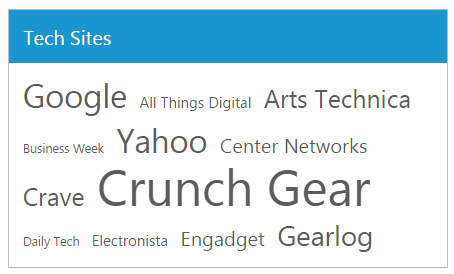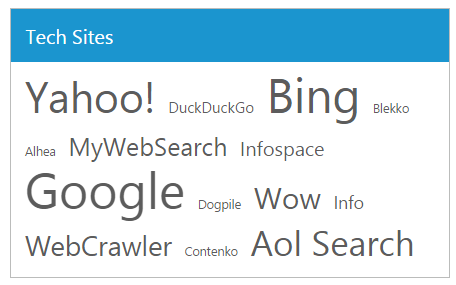Getting Started
23 Nov 201712 minutes to read
This section explains briefly about how to create a TagCloud in your application with JavaScript. The TagCloud can be easily configured to the div element in which the tags are placed. The following screenshot illustrates the functionality of a TagCloud widget with a list of the topmost search engines.

Create TagCloud widget
Create an HTML file and add the following template to the HTML file.
<!DOCTYPE html>
<html>
<head>
<!-- Style sheet for default theme (flat azure) -->
<link href="http://cdn.syncfusion.com/28.1.33/js/web/flat-azure/ej.web.all.min.css" rel="stylesheet"/>
<!--Scripts-->
<script src="http://cdn.syncfusion.com/js/assets/external/jquery-1.10.2.min.js"></script>
<script src="http://cdn.syncfusion.com/js/assets/external/jquery.easing.1.3.min.js"></script>
<script src="http://cdn.syncfusion.com/28.1.33/js/web/ej.web.all.min.js"></script>
<!--Add custom scripts here -->
</head>
<body>
<!--Add necessary HTML elements-->
<!--Apply Scripts-->
</body>
</html>Add necessary HTML elements.
<div id="tagcloud"></div>Add the following code example before </body> tag to add list of items to the TagCloud and initialize the TagCloud widget using dataSource and titleText properties.
$("document").ready(function (event) {
var websiteCollection = [
{ text: "Yahoo!", url: "http://search.yahoo.com/", frequency: 20 },
{ text: "DuckDuckGo", url: "https://duckduckgo.com/", frequency: 5 },
{ text: "Bing", url: "http://www.bing.com/", frequency: 23 },
{ text: "Blekko", url: "http://blekko.com/", frequency: 4 },
{ text: "Alhea", url: "http://www.alhea.com/", frequency: 3 },
{ text: "MyWebSearch", url: "http://home.mywebsearch.com/index.jhtml", frequency: 10 },
{ text: "InfoSpace", url: "http://infospace.com/", frequency: 8 },
{ text: "Google", url: "https://www.google.co.in/", frequency: 24 },
{ text: "DogPile", url: "http://www.dogpile.com/", frequency: 4 },
{ text: "Wow", url: "http://www.wow.com/", frequency: 14 },
{ text: "Info", url: "http://www.info.com/", frequency: 6 },
{ text: "WebCrawler", url: "http://www.webcrawler.com/", frequency: 12 },
{ text: "ContenKo", url: "http://www.contenko.com/", frequency: 3 },
{ text: "Aol Search", url: "http://search.aol.com", frequency: 16 },
];
$("#tagcloud").ejTagCloud({
dataSource: websiteCollection,
titleText: "Tech Sites"
});
});The following screenshot displays the output of the above code example.

Set Min and Max Font Size
In the above code example, the frequency properties are used to set the min and max font size to the TagCloud list item.
$("document").ready(function (event) {
var websiteCollection = [
{ text: "Yahoo!", url: "http://search.yahoo.com/", frequency: 20 },
{ text: "DuckDuckGo", url: "https://duckduckgo.com/", frequency: 5 },
{ text: "Bing", url: "http://www.bing.com/", frequency: 23 },
{ text: "Blekko", url: "http://blekko.com/", frequency: 4 },
{ text: "Alhea", url: "http://www.alhea.com/", frequency: 3 },
{ text: "MyWebSearch", url: "http://home.mywebsearch.com/index.jhtml", frequency: 10 },
{ text: "InfoSpace", url: "http://infospace.com/", frequency: 8 },
{ text: "Google", url: "https://www.google.co.in/", frequency: 24 },
{ text: "DogPile", url: "http://www.dogpile.com/", frequency: 4 },
{ text: "Wow", url: "http://www.wow.com/", frequency: 14 },
{ text: "Info", url: "http://www.info.com/", frequency: 6 },
{ text: "WebCrawler", url: "http://www.webcrawler.com/", frequency: 12 },
{ text: "ContenKo", url: "http://www.contenko.com/", frequency: 3 },
{ text: "Aol Search", url: "http://search.aol.com", frequency: 16 },
];
$("#tagcloud").ejTagCloud({
dataSource: websiteCollection,
titleText: "Tech Sites"
});
});In the above code, the min font size is 3 and max font size is 24.
Set event to perform an operation
Here, you can set the TagCloud events such as create, mouseover, mouseout, click.
$("document").ready(function (event) {
var websiteCollection = [
{ text: "Yahoo!", url: "http://search.yahoo.com/", frequency: 20 },
{ text: "DuckDuckGo", url: "https://duckduckgo.com/", frequency: 5 },
{ text: "Bing", url: "http://www.bing.com/", frequency: 23 },
{ text: "Blekko", url: "http://blekko.com/", frequency: 4 },
{ text: "Alhea", url: "http://www.alhea.com/", frequency: 3 },
{ text: "MyWebSearch", url: "http://home.mywebsearch.com/index.jhtml", frequency: 10 },
{ text: "InfoSpace", url: "http://infospace.com/", frequency: 8 },
{ text: "Google", url: "https://www.google.co.in/", frequency: 24 },
{ text: "DogPile", url: "http://www.dogpile.com/", frequency: 4 },
{ text: "Wow", url: "http://www.wow.com/", frequency: 14 },
{ text: "Info", url: "http://www.info.com/", frequency: 6 },
{ text: "WebCrawler", url: "http://www.webcrawler.com/", frequency: 12 },
{ text: "ContenKo", url: "http://www.contenko.com/", frequency: 3 },
{ text: "Aol Search", url: "http://search.aol.com", frequency: 16 },
];
$("#tagcloud").ejTagCloud({
dataSource: websiteCollection,
titleText: "Tech Sites",
create: "create",
mouseover: "mouseover",
mouseout: "mouseout",
click: "click",
width: "auto"
});
});
function create(args) {
alert();
}
function mouseover(args) {
alert();
}
function mouseout(args) {
alert();
}
function click(args) {
alert();
}In the above code example, the alert() function is used to show the events that happened.